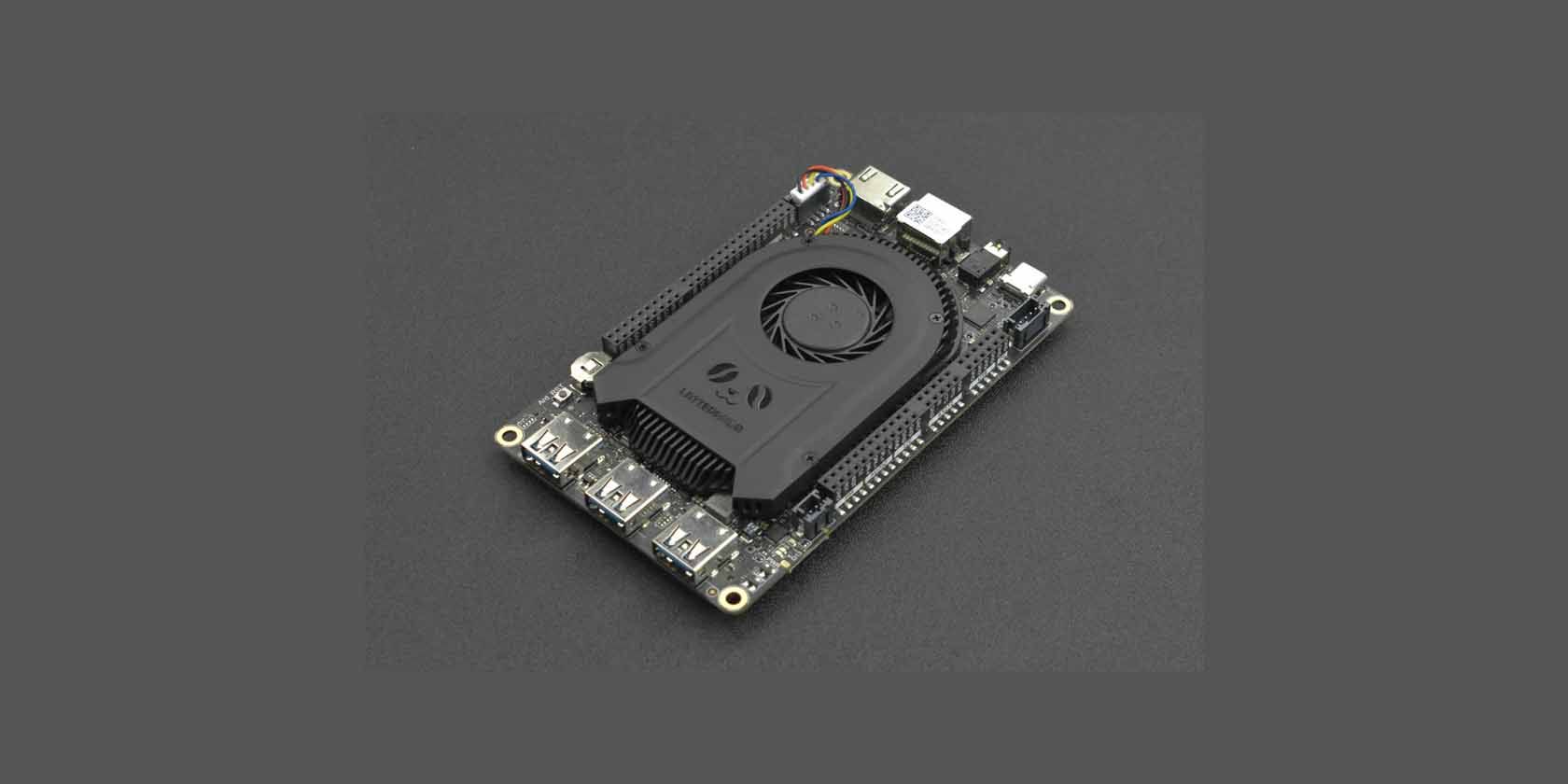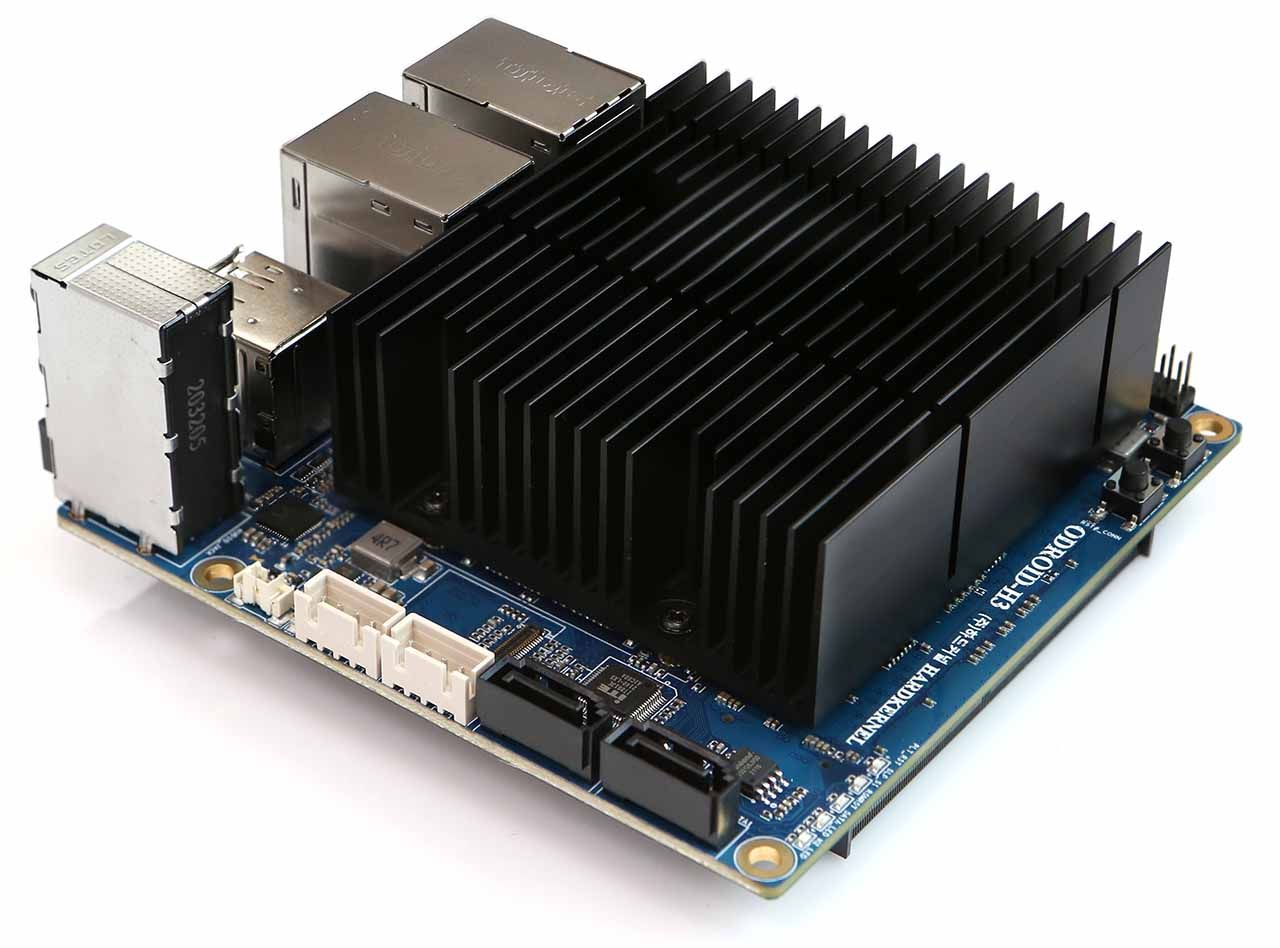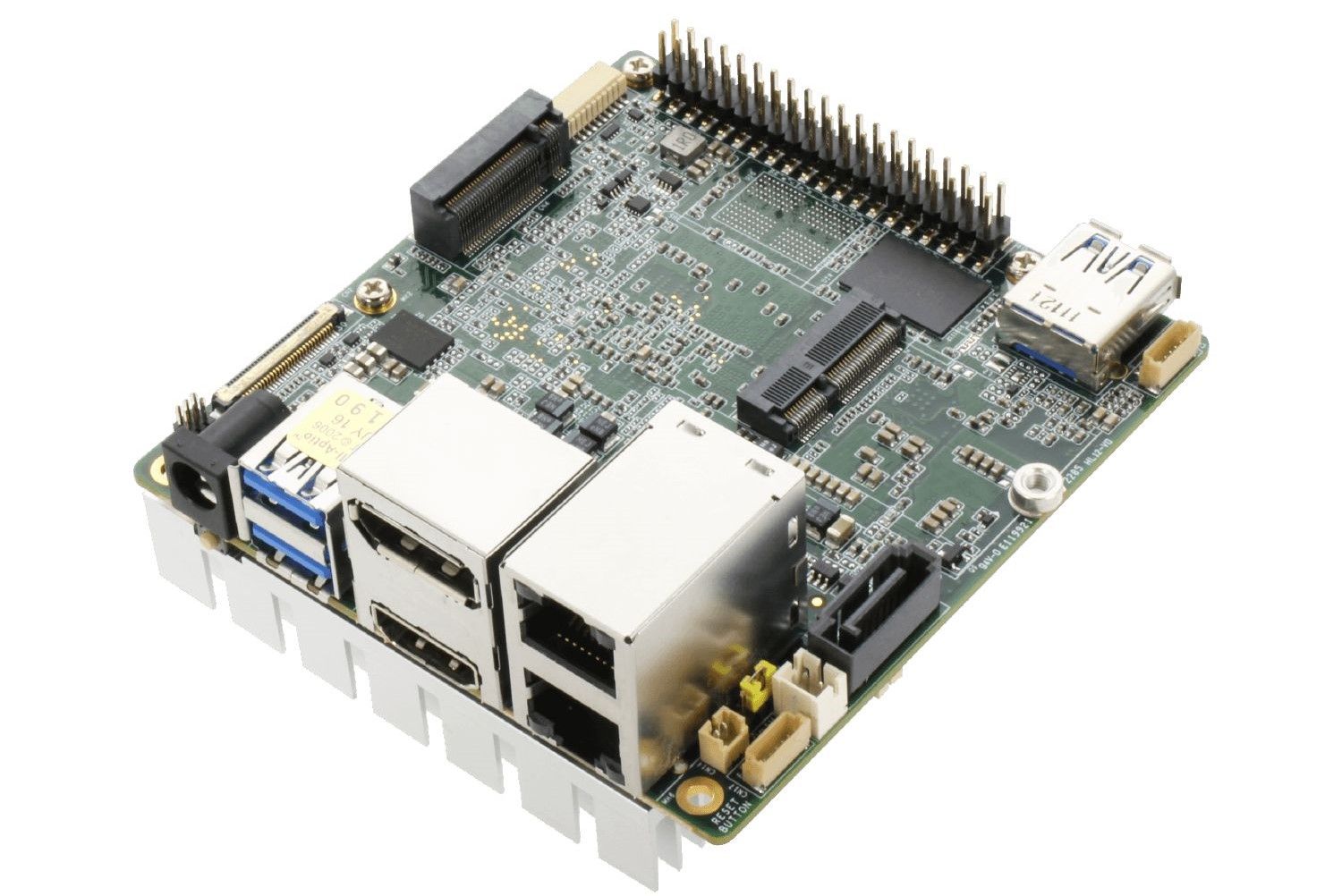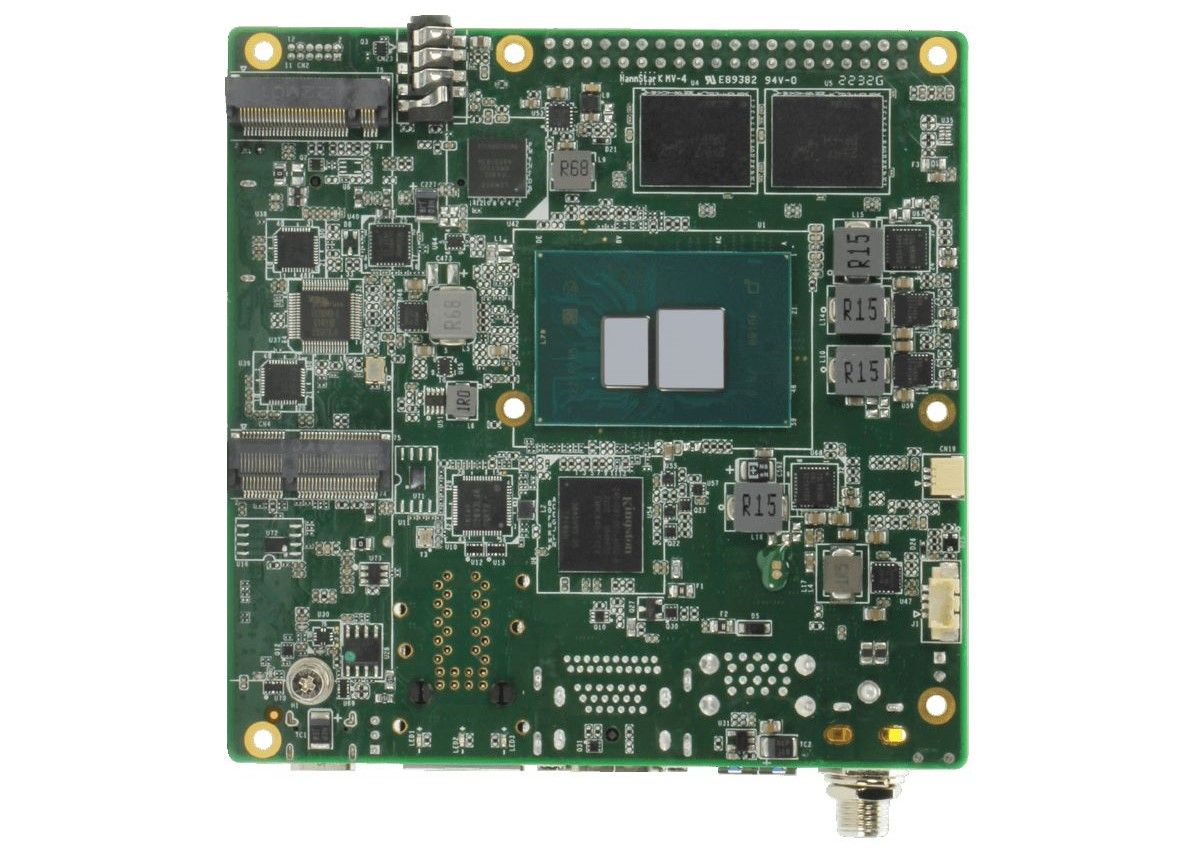Although ARM-based single-board computers are more popular by far, there’s a time and place for x86 SBCs. In general, they often pack more of a punch and can be used in applications where power consumption is of lesser concern than performance such as server hosting and emulation.
LattePanda 3 Delta
The LattePanda 3 Delta is a powerful single-board computer capable of running Windows and Linux. It is slightly larger than the Raspberry Pi 4 and has its quad-core processor nested under an onboard heatsink and fan.
In true SBC fashion, you are almost spoilt for choice with the input/output connectivity offered by this board. The LattePanda Delta 3 contains an Arduino Leonardo ATMEGA32U4 coprocessor that can be connected to electronics via the GPIO pins on board and also comes with an RTC battery to power the real-time clock.
|
Processor |
Intel Celeron N5105 capable of running at a clock speed of 2.0GHz to around 2.9GHz (burst) |
|
GPU |
Intel UHD Graphics (frequency: 450 to 800MHz) |
|
RAM |
LPDDR4 8GB 2933MHz |
|
Storage |
64GB eMMC V5.1, microSD card slot |
|
Ports |
1 x USB-C (Power Delivery only), 1 x USB-C (3.1, Display Port 1.4, and Power Delivery), 1 x HDMI 2.1 (8K@60Hz) |
|
Expansion Slots |
1 x M.2 M Key, 1 x M.2 B Key |
|
Networking |
Wi-Fi 6, Bluetooth 5.2, Intel Gigabit Ethernet |
|
Coprocessor |
ATMEGA32U4 |
|
Other Features |
3 x MIPI CSI connectors, 2 x MIPI DSI connectors, 2 x 30-pin GPIO expansion header |
|
Power |
USB-C Power Delivery 12V 2A (24W) |
|
Price |
$279 (unactivated), $339 (with Windows License) |
Odroid H3+
The Odroid H3+ is one of the few x86 offerings from Hardkernel and seeks to replace the older H2. It comes with an Intel quad-core processor with a boost clock speed of 3.3GHz and supports up to 64GB DDR4 RAM in dual-channel mode and housed in SODIMM slots. The integrated graphics card is clocked at 900MHz and a real-time clock battery comes with the board.
The Odroid H3+ features an onboard heat sink and also has a 4-pin fan connector if your project requires active cooling. There's no wireless networking module on this board, but it has two onboard Gigabit Ethernet ports.
|
Processor |
Intel Celeron N6005 (up to 3.3Ghz) |
|
GPU |
Intel UHD Graphics (24/32 EU up to 900MHz) |
|
RAM |
2 x DDR4 SO-DIMM slots, dual-channel memory support, up to 64GB |
|
Storage |
eMMC socket, microSD card slot |
|
Ports & Expansion |
2 x USB 3.0, 2 x USB 2.0, 1 x HDMI 2.0 (up to 4K@60Hz), 1 x DisplayPort 1.2 (up to 4K@60Hz), 1 x Audio-in, 1 x Audio-out, 2 x SATA 3.0 ports, 1 x PCIe 3.0(4 lanes) |
|
Networking |
2 x Gigabit Ethernet |
|
Other Features |
24-pin GPIO expansion header, 5 x System LED indicators, passive heatsink, power and reset buttons |
|
Power |
DC 14V ~ 20V (up to 60W) via power jack |
|
Price |
$165.00 (minus power supply) |
Up Squared V2
The Up Squared V2 is a 2022 release from the UPboard company and is intended as the successor to the UP Squared series. There are two versions, each based on a different SoC (System-on-Chip), one with the Intel Pentium J6426 processor and the other with the Intel Celeron N6210 (formerly Elkhart Lake).
It features a 40-pin GPIO expansion header and comes with a passive heatsink and RTC battery on the board. It is larger than the Raspberry Pi 4B, coming up at 85.6 mm long and 90 mm wide. The Raspberry Pi 4B measures 85.6 mm × 56.5 mm, for comparison. This x86 board is still compact and portable enough for embedded projects. Also, the rate of power consumption is relatively low for the performance it offers.
The Up Squared V2 is also suitable for industrial applications with a standard 12V DC power input and a hardware TPM v2.0 module. It is also capable of displaying 4K content at 60Hz on as many as three monitors at the same time.
|
Processor |
Intel Celeron N6210 (up to 2.6 GHz), Intel® Pentium® J6426 (up to 3.0 GHz) |
|
GPU |
Intel UHD Graphics |
|
RAM |
2GB, 4GB, 8GB, 16GB |
|
Storage |
32GB or 64GB eMMC storage |
|
Ports & Expansion |
2 x USB 2.0 via 10-pin wafer, 3 x USB 3.2 Gen 2 Type-A, 1 x HDMI 1.4b, 1 x DP 1.2, 1 x M.2 2230 E Key, 1 x M.2 2280 M Key |
|
Networking |
2 x Gigabit Ethernet |
|
Other Features |
40-pin GPIO expansion header, passive heatsink, RTC battery, TPM 2.0 |
|
Power |
12V DC @ 5A via power jack |
|
Price |
$179-$359 (excluding tax) |
UDOO Bolt V8
The UDOO Bolt V8 is not a single-board computer in the strictest sense of the term, since it houses its RAM sticks in SODIMM slots and not directly on the board. It is more accurately referred to as a maker board, as it features a rich amount of connectivity options embedded in its slim frame.
It comes with an AMD Ryzen Embedded V1605B processor with four cores and eight threads, capable of running at 2GHz normally and 3.6GHz with a boost. It has the same coprocessor as the LattePanda 3 and the Arduino ATMEGA32U4.
The UDOO Bolt V8 is a pricey board at over $500, plus taxes and shipping. You can also get the slightly underpowered UDOO Bolt V3 for about $100 less. If you are in the market for a single-board computer that won't burn a hole in your wallet, take a look at our list of the cheapest SBCs.
|
Processor |
AMD Ryzen Embedded V1605B, quad-core/eight-thread @2GHz (3.6GHz Boost) |
|
GPU |
AMD Radeon Vega 8 Graphics (8 GPU Compute Units) |
|
RAM |
2 x DDR4 SO-DIMM, dual-channel, with support up to 32GB |
|
Storage |
32GB EMMC 5.0 High Speed Drive |
|
Ports & Expansion |
2 x USB 3.0 Type-A, 2 x USB Type-C, 2 x HDMI 1.4 / 2.0A, 1 x M.2 Socket 2 Key B for SSD SATA modules, 1 x M.2 Socket 3 Key M for NVMe modules |
|
Networking |
Gigabit Ethernet |
|
Coprocessor |
ATMEGA32U4 |
|
Other Features |
40-pin GPIO expansion header, passive heatsink and fan controller, RTC battery, |
|
Power |
19V @5A DC via power jack, USB Type-C Power Delivery |
|
Price |
$550.00 |
Up Squared Pro 7000
The Up Squared Pro 7000 is an Intel-based single-board computer released in early 2023. It is the latest addition to the Up Squared Pro series and features a number of upgrades, such as a more powerful processor, a better graphics card, and more expansion ports and interfaces.
There are four possible options for the onboard SoC, Intel N50, Intel N97, Intel Atom x7425E, or the IntelCore i3-N305. These models all vary in performance and price, with the Intel N50 being the cheapest and the Core i3 is the most expensive. Regardless, all models are designed to consume as little power as possible while offering maximum performance.
The Up Squared Pro 7000 is aimed at professional makers and features hardware optimized for robotics, automation, the Internet of Things, and artificial intelligence applications.
|
Processor |
Intel Core i3-N305, Intel Atom x7425E, Intel Processor N97, or Intel Processor N50 |
|
GPU |
Intel UHD Graphics Gen 12 |
|
RAM |
Up to 16GB LPDDR5 |
|
Storage |
Up to 64GB eMMC |
|
Ports & Expansion |
2 x USB 2.0 via 10-pin wafer, 2 x USB 3.2 Gen 2 Type-A, 1 x USB 3.2 Gen 2 Type-C, 1 x HDMI 2.0, 1 x DP 1.2, 1 x M.2 2230 E-key, 1x M.2 2280 M-key, 1 x M.2 3052 B-key |
|
Networking |
2 x Gigabit Ethernet ports |
|
Other Features |
40-pin GPIO expansion header, passive heatsink, watchdog timer, RTC battery, TPM 2.0 |
|
Power |
12V DC @ 6A via power jack |
|
Price |
$227-$449 (excluding tax) |
The Best x86 SBCs You Can Buy Right Now
There is a plethora of advantages to using an x86 SBC. This includes higher processing performance and compatibility with more operating systems. If you are heavily invested in running Windows or running demanding emulators, an x86 SBC is a much better choice. It will also serve you better if you would rather not cross-compile your favorite apps or don’t know how.




